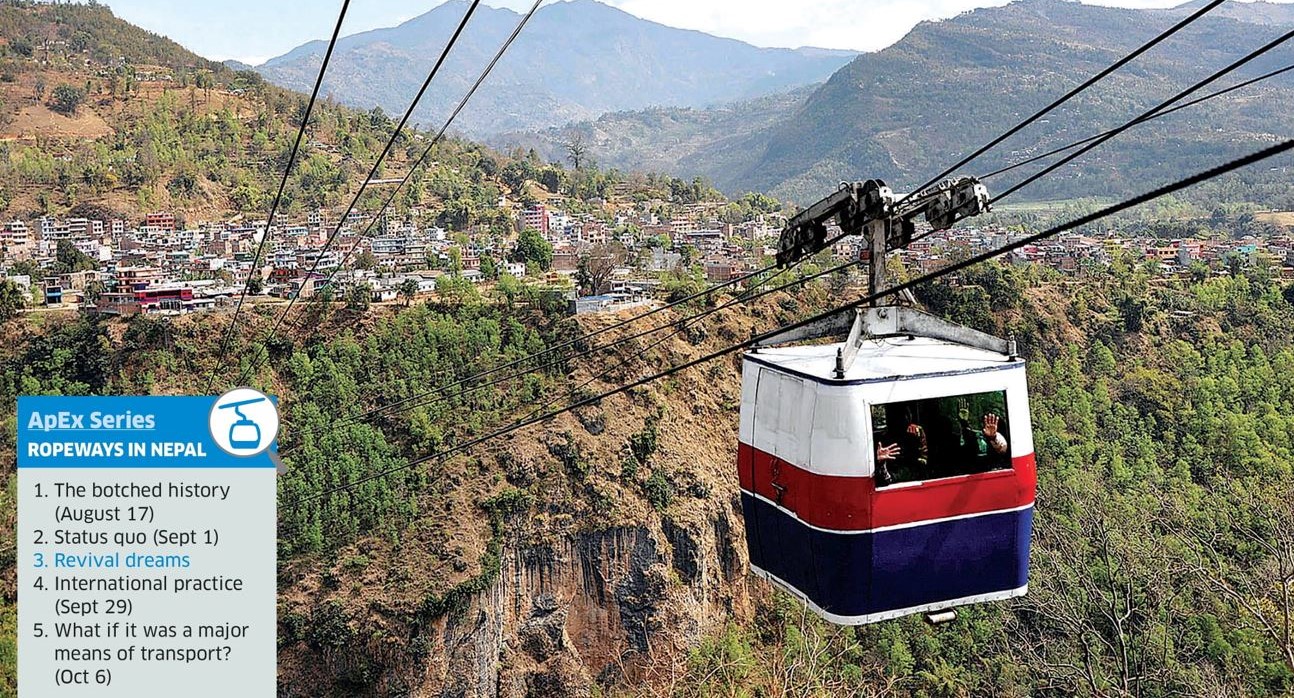This year marks the centenary of the start of ropeway in Nepal. Renewable Energy Confederation of Nepal (RECON), Nepal Ropeway Association, USAID and other relevant institutions are planning to celebrate the 100 years by holding seminars on the importance, relevancy, and revival of ropeway technology in Nepal. They are planning to conduct the seminars in all seven provinces and invite the concerned government representatives. They hope these events will push the government authorities to rethink the revival of ropeway transport in Nepal.
The government so far has shown no interest in developing ropeway system in Nepal. Tulsi Gautam, spokesperson for the Ministry of Physical Infrastructure and Transport, says, “The government as of now has no plans to commission a ropeway project on its own.” This is despite the fact that the government is aware of the ropeway’s potential in Nepal and its suitability in terms of both cost and practicality.
Several studies on ropeway potential in Nepal suggest the country could have ropeway transports in nearly 2,000 areas and feasibility studies have also been conducted in 62 of these locations. To date, there are only five ropeways for human transport and almost a dozen gravity goods ropeways are in operation in Nepal. The book ‘Ropeways in Nepal’ by Dipak Gyawali, Ajaya Dixit, and Madhukar Upadhya recounts many past success stories of Nepali ropeway projects, but the idea of developing ropeways to ease the problem of transporting goods and humans has simply not registered on the minds of the government officials and ministers.
“The fact is the government officials and ministers do not get much commission from ropeway development unlike road projects,” says Gyawali, who is also a former water resource minister. After the success of pioneering ropeway projects, the government incorporated plans and policies for improving and extending the existing ropeway services in the fifth Five-Year Plan. With grant assistance from the US government, the old 22-km long, low-capacity mono-cable system between Dhorsing and Kathmandu was replaced and extended with a 42-km-long bi-cable ropeway between Hetauda and Kathmandu. The sixth Five-Year Plan proposed developing gravity ropeways in the hills and mountains to transport daily goods and Rs 6m was allocated to execute the plan, but nothing came of it.
After the restoration of multi-party democracy in the 90s, the eighth Five-Year Plan incorporated ropeway under the sub-sector of ‘other modes of transport’ and announced a program for consolidating the existing ropeways and operating them at full capacity. There was also the plan of encouraging the private sector for the development of short-haul ropeways to promote tourism as well as developing gravity ropeways. For these purposes, the government of the time allocated Rs 158m. The next national plan announced a more ambitious 20-year National Transport Master Plan that included a cable car/ropeway development program and privatization of ropeway transports so that they could be operated more effectively.
The approach paper of the 10th Five-Year Plan (2002-2007) again stated that policies for developing ropeway transportation would be adopted. It also set the aim of encouraging private entrepreneurs to construct and operate cable car/ropeways in places with importance for tourists and local economies where road access is lacking. Priority for cable car/ropeway development would be accorded to those areas where the cost of constructing and operating roads would be comparatively high.
Experts say though policies and modest-scale programs were incorporated in Nepal’s Five-Year Plans, the progress over the years have been slow. In fact, they add, the ropeway development plan has more or less remained stagnant since 2007. Its potential to become an important segment of the country’s transport system was not realized. Post 2007, the Five-Year Plans had no mention of policies on ropeway development.
Upadhyay, the co-author of ‘Ropeways in Nepal’, says Nepal is in the 15th Five-Year Plan, but for the last two decades, there has not been any progress on ropeway development. Like Gyawali, he too is the view that the political leadership is deliberately ignoring the ropeway potential because they do not get any financial gains. “If the government ministers and politicians agree to build ropeways instead of roads, they cannot earn commissions.” Upadhya, who was in-charge of building the Bhattedanda ropeway, adds unlike ropeways, roads need to be maintained regularly, which brings in large funds for politicians and contractors.
Experts say ropeways can be a viable solution for not just transporting goods and people, but also in the process of managing municipal waste. Guna Raj Dhakal of Ropeway Nepal Pvt Ltd says the system could be utilized to transport the waste generated in Kathmandu Valley. “There has even been a study on this issue, but there was no follow up. The plan never took off.”
Gyawali says the ‘Ropeway in Nepal’ was launched in presence of the then ministers and officials from the National Planning Commission (NPC) and that they know the ropeway could transform Nepal, but they are still not comfortable with the idea. “This simply reflects the unwillingness of the government towards sustainable and cost-effective development ideas,” he adds. To date, the NPC has not started any discussion on the feasibility of ropeways. Asked why, the commission member, Uma Shankar Prasad had no answer.













